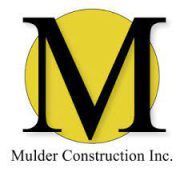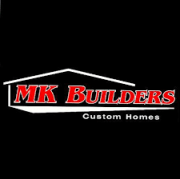You can’t choose just any type of roofing material for a low-slope roof. As easy as it might seem to just shingle a low slope area of your roof, it’s not the ideal material for it. So today we’re going to go over the best low slope roofing options (plus their pros and cons) so you don’t make the mistake of choosing the wrong one.
The Basics: What is a Low Slope Roof?
Often called “flat roofs”, a low slope roof is defined as a roof area that slopes 2″ to 4″ in 12″ of a run.
So this means that for every foot of roofing area, the pitch goes down 2 to 4 inches. This makes the roof pitch anywhere from 4 to 10 degrees. For comparison, the standard pitch of a home’s roof is between 4/12 and 9/12, or a pitch of up to 36.37 degrees.
Roofing systems that rely on sufficient drainage for successful performance, such as slate or asphalt shingles, are not utilized on low slope roofs since they drain water more slowly than moderate or steep-sloped roofs. Other challenges of a low slope or flat roof include:
More Foot Traffic
Since low slope roofs are more accessible or even utilized as rooftop patios, etc., they can receive more foot traffic than steeper roofs. This means that the roofing system needs to be able to withstand this increased activity without breaking down. So shingles are not usually the ideal option in this case.
Slow Draining
The steeper the slope, the faster water and snowmelt can shed off a roof. With the minimum slope of a low slope roof, that water is going to take much longer to drain, if at all. So a low slope roof needs to have a system in place that can handle this increased pooling of water.
Pooling Water
We just talked about how low-slope roofs can have standing water due to the slow drainage, but this also creates other problems.
The pooling water can cause leaks in the roof system as well as create areas where moss and algae can grow. So it’s vital to have the best material possible that will not allow pooling water to stick around.
More Weight on a Bigger Area
Some low slope roofs have a much larger surface area and the roofing materials will cause a greater weight on the roof, which can lead to risks of sagging and deterioration. So if you have a larger area low slope roof, a lighter material like rubber or PVC.
UV Degradation ☀️
Most likely your moderate or steep pitched roof only gets sun for a part of the day. It gets shadows cast that can cool it down from being in the high noon sun. A low slope roof, however, sees the sun for the majority of the day which means it can experience extensive UV degradation. This wear and tear can cause fading and cracking.
While these challenges sound severe, they can be combated by utilizing the best roofing material available to you that is meant for a low-slope roofing solution.
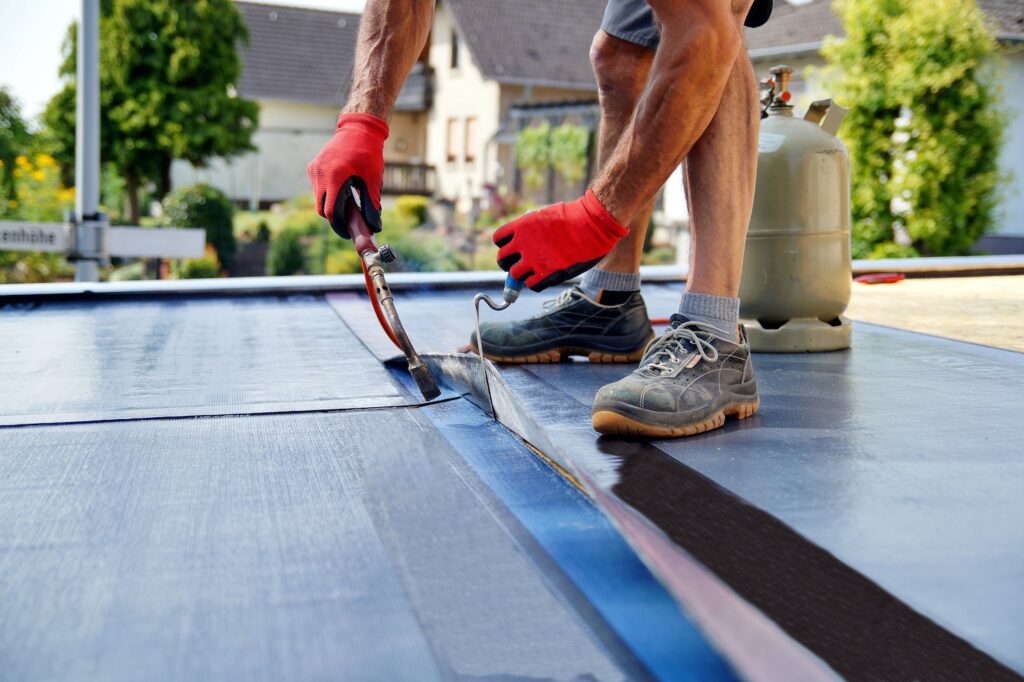
The Best Materials for a Low Slope Roof (Pros and Cons)
While technically you could install an asphalt shingle roof on a low slope, we do NOT recommend it. You are just asking for a leak to happen if you install conventional roofing material on your low-slope roof. Instead, you should consider one of the 4 main types of flat roof materials:
- Built-Up Roofing (BUR)
- Modified Bitumen
- Ethylene Propylene Diene Monomer (EPDM)
- Thermoplastic Polyolefin (TPO)
While these aren’t the only options to you, they are very commonly used and are intended for such an application. We’ll dive into the pros and cons of each and determine which is the best for either residential or commercial roofs.
Built-Up Roofing (BUR)
One of the oldest types of low slope roofing systems, BUR has been around for well over 100 years. It’s composed of multiple layers (usually between three and five) of asphalt that is alternated with reinforcing fabrics and adhesives. The top layer is then finished with a gravel or mineral surface.
Pros:
- Excellent at resisting UV rays and weathering
- Can last 20-30 years with proper maintenance
- Multi-layered protection— if one is damaged the others below it pick up the slack
Cons:
- Heavier than other roofing materials so requires a stronger roof deck
- Installation is slower and more labor-intensive which can drive up costs
- Can be difficult to spot leaks
Modified Bitumen
Modified Bitumen is similar to BUR as it’s also asphalt-based, but it has far fewer layers and the application is a bit different. Its first base layer is adhered to the roofing substrate or deck, then a top cap sheet can be torched, cold applied, or self-adhered. It can also be applied as a layer of hot asphalt.
Pros:
- Resistant to tears
- A white “cool roof” can be applied to reflect sunlight making it even more energy-efficient
- Easily expands and contracts without cracking or losing its shape
- There are no seams which means less opportunity for leaks
- It’s very thick which can resist punctures (great for foot traffic)
Cons:
- Can be expensive
- Doesn’t have protective granules for UV rays
- If water pools on the roof, it can quickly deteriorate a modified bitumen roof
Ethylene Propylene Diene Monomer (EPDM)
EPDM is the most common thermoset roof membrane and is applied in large sheets. It’s black and quite flexible which makes it ideal for low slope roofs. It’s a more modernized synthetic version of traditional black rubber roofs.
Pros:
- One of the most affordable types of roofing materials
- Fire-resistance
- Last 20+ years
- Made of 100% recyclable material
Cons:
- Can puncture easily
- It’s not aesthetically pleasing— may be best used on commercial properties
- The seams risk breaking down and causing water leaks over time
Thermoplastic Polyolefin (TPO)
TPO is a relatively new roofing material compared to the other types. It is a single-ply membrane and much like the other flat roofing materials, can be applied in one of three ways:
- adhered using bonding adhesives
- mechanically attached
- or mechanically attached at the seams
Pros:
- The white coating reflects UV rays and keeps structures cooler
- Lasts 25+ years with proper installation
- High water-resistance
- Low maintenance and easy to install
Cons:
- Complicated to repair
- Can be expensive
- Different brands or manufacturers can be inconsistent in quality
- Very slippery when wet
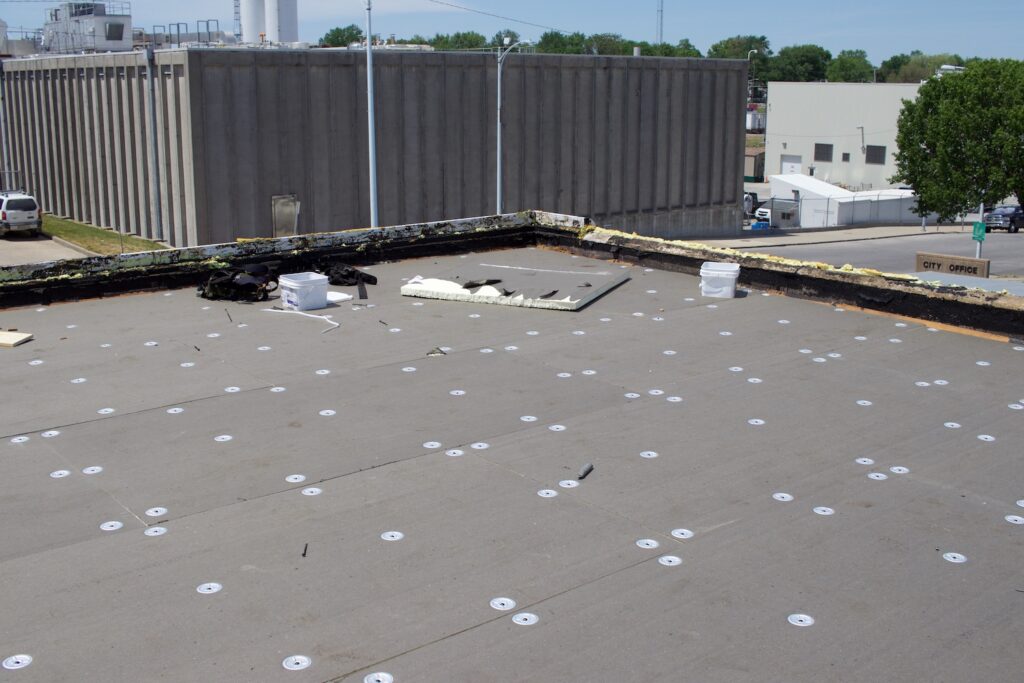
Maintenance Tips for Flat and Low Slope Roofs
Low slope roofs (and all roofs) rely heavily on the maintenance of a homeowner and local roofers to ensure it stays durable and long-lasting. In order to be well-maintained, there are some vital tips for homeowners and business owners to follow in order to uphold the integrity of their low-slope roof.
1) Perform Regular Roof Inspections ️♂️
Every roof should be visually inspected every year. This is when you can spot things like cracks, pooling water, debris, or leaks. But a more thorough inspection by a professional should be performed every 3-5 years, if not more.
2) Trim Overhanging Trees
Overhanging trees are a major risk to your roof. If a large storm comes through and a tree topples onto the roof or even large branches fall onto the roof’s surface, it can crack, dent, or penetrate your roofing material. So keep them trimmed back so they don’t hang over the roof’s edge.
3) Keep the Roof Free of Debris
It’s natural for debris like leaves and sticks to blow onto your roof, but the longer they sit, the more risk you are for mold growth or clogged gutters. Both of which can cause roofing issues and leaks.
4) Check Seams for Leaks
If you have a low slope roof, be sure to keep an eye on the seams. Over time, they can loosen and cause leaks. Regularly check them for any signs of wear or tear and you can easily reseal them with your top coating or re-apply the roofing material over the damaged seams.
5) Limit Foot Traffic
While some commercial flat roofs can expect to have foot traffic for maintenance on HVAC or other structural repairs, limiting how often people are up there can ensure the roof lasts longer. Heavy work boots can scuff or even rip seams on an aging flat roof— so best to keep the same walking areas that are reinforced so the roof stays protected.
6) Have a Proper Drainage System
While a flat roof technically has a low slope to ensure water drainage, it still can struggle with draining water, snow, and ice. And without a proper drainage system, that gets even harder. There should be gutters with gutter guards and downspouts to draw any rainwater away from the structure.
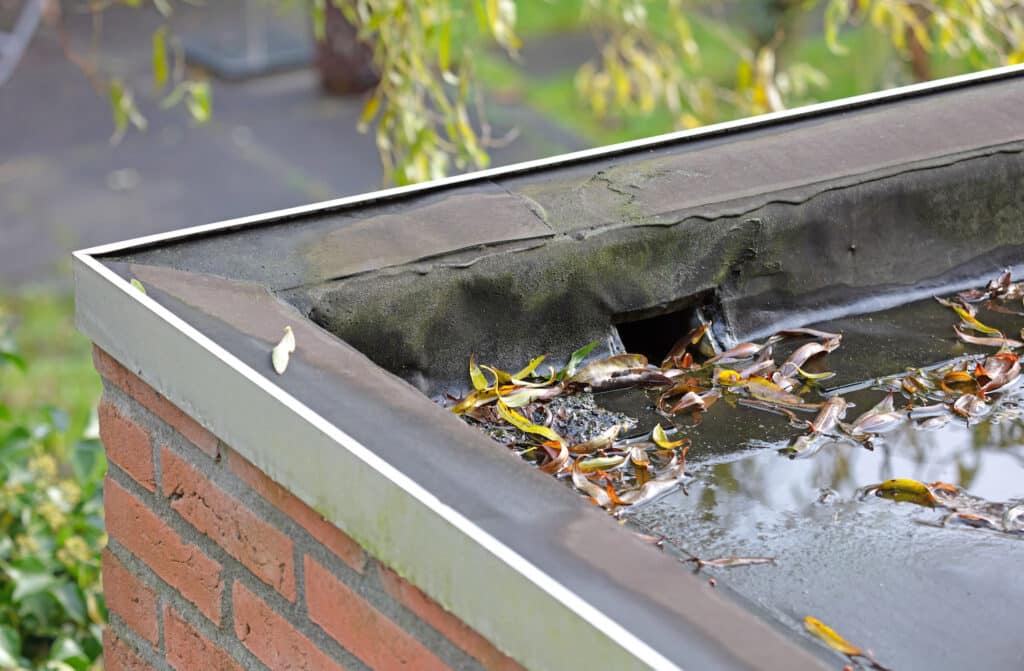
7) Schedule Professional Snow and Ice Removal ❄️
While you may be able to clear the majority of snow and ice off your low-slope roof, it’s best to leave the job to professionals. They have special equipment that can safely remove any build-up on your roof without damaging the roofing material or causing any further issues.
8) Don’t Put Off Repairs
Failing to repair your roof when you first see the damage can be detrimental to the health of your roofing system. If you have homeowner’s insurance you can also file a claim on bigger repairs— but the sooner you act, the better.
9) Check for Blistering or Cracking
Constant sun and weather exposure can wreak havoc on your low slope roofing materials causing them to blister or crack. Watch for these during your annual inspection to catch leaks before they happen.
10) Watch for Pooling Water
Pooling water can happen when you don’t do any of the above maintenance steps. And when water pools on your low slope roof, it can eventually cause a roof collapse or massive leak. So spotting pooling water can actually help pinpoint those weak spots in your roof that need reinforcement or replacement.
When you’re doing roof maintenance, safety comes first. Never get up on a roof that is unsafe and always have a roofing harness on. Also, working with a friend can help ensure you are safe and you always have a ladder partner. But ultimately, leaving both installation and maintenance to the pros can help keep your roof in the best condition— and keep you safe from falls or mistakenly voiding your warranties.

Hiring a Reputable Contractor to Get the Job Done
Working with a reputable contractor like Apple Roofing is the best thing you can do for your low-slope roof. Protect your structure with a premium flat roof installed by a team that cares. Reach out to Apple Roofing, today.











